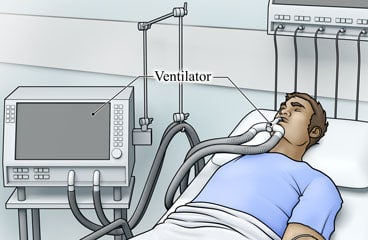How does breathing support work in the ICU?

An ICU is a part of the hospital where very sick people get care. One reason a person might be in an ICU is for trouble breathing. The ICU has special equipment to help people breathe. The doctor may use different equipment depending on how hard it is for the person to breathe.
- A ventilator is a machine that breathes for a person. It sends oxygen and air into the lungs through a thin tube and allows carbon dioxide to escape. The tube is placed in the windpipe through the nose or mouth. If the person needs the ventilator for a long period of time, a tube is placed in an opening made directly into the windpipe through the neck. This is called a tracheostomy, or "trach" (say "trayk"), tube.
- A continuous positive airway pressure (CPAP)machine may be used when a ventilator isn't needed. It gently pushes oxygen and air into the lungs through a mask over the nose and mouth. People can breathe on their own with this extra help.
- A nasal cannula is a plastic tube with two prongs that are placed in the nostrils when a person just needs more oxygen. The oxygen goes through the tubes and into the nostrils.
- Oxygen may also be given through a mask. Oxygen flows through a tube and into a mask that is placed over the nose and mouth.
The equipment that helps a person breathe may need to be adjusted a lot. If you have questions about breathing support, the care team can help explain the different types of equipment and how they work.
Other devices are used to track breathing and the heart.
- A heart monitor has a sensor that attaches to the chest to track heart rate and rhythm.
- A pulse oximeter clips to the end of the finger. It measures how much oxygen is in the blood.
- An arterial line is a thin, flexible tube that is placed into an artery. This line is usually placed in the wrist or groin. Blood samples can be taken to measure the oxygen and carbon dioxide in the blood. The arterial line can also measure blood pressure.
What can you expect in the ICU?
Over time, people in the ICU may not need as much breathing support. As a person gets stronger, the doctor may move (or wean) them from a ventilator to a CPAP machine, then to a mask or nasal cannula with oxygen, and finally to breathing without the need for help. The tubes from the machines supply air and oxygen.
Ventilators and other equipment have alarms that alert the care team to any sudden changes. Often an alarm is not a reason for concern, but the care team may come in and check an alarm. If you have questions about any alarms, you can ask the care team.
The ICU staff is highly trained to care for very sick people. They will do everything they can to help you understand what care your loved one is getting.
You are an important part of the care team to support your loved one. If you are worried and have concerns, ask for support from friends and family. You can also ask the hospital staff about counseling and support.
Current as of: September 29, 2025
Author: Ignite Healthwise, LLC Staff
Clinical Review Board
All Ignite Healthwise, LLC education is reviewed by a team that includes physicians, nurses, advanced practitioners, registered dieticians, and other healthcare professionals.

